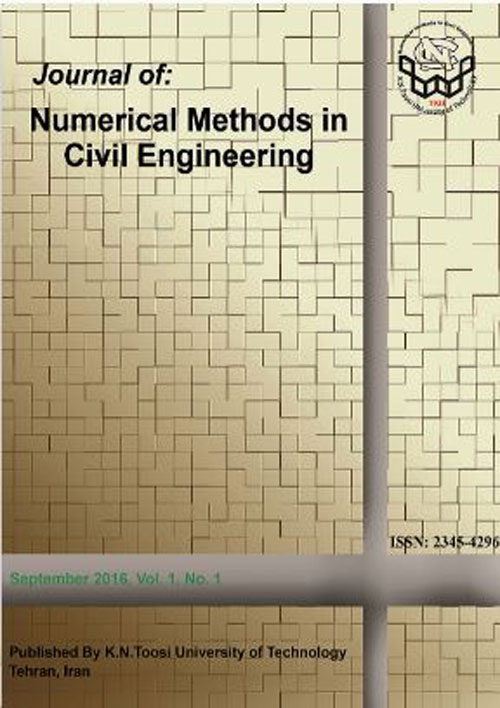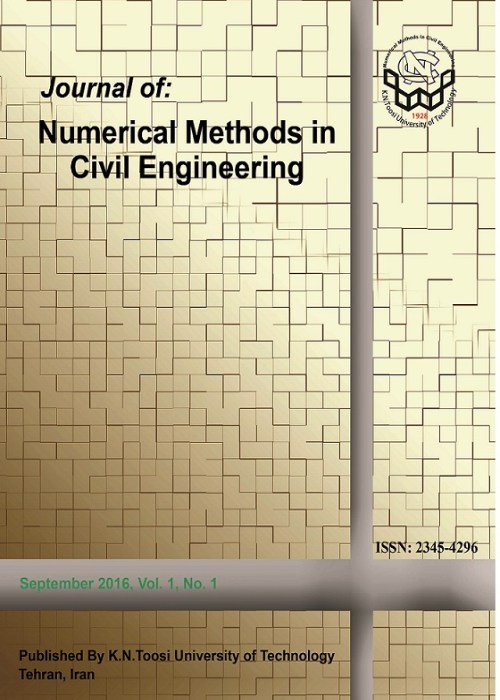فهرست مطالب

Journal of Numerical Methods in Civil Engineering
Volume:7 Issue: 1, Sep 2022
- تاریخ انتشار: 1401/05/31
- تعداد عناوین: 8
-
-
Pages 1-8
The drops are used to control the descents, stabilize the bed level, and control the upstream water level in sloping channels with less slope than the ground slope. The current study presents a numerical analysis of hydraulic characteristics in the vertical drop using computational fluid dynamics. At first, the laboratory models were used for verification and choosing the best model of turbulence; three types of turbulence models, k-ε, k-ε RNG, and k-ωwere used. The results revealed that the RNG k-ε turbulence model has less RE% and RMSE than other models and more efficiency in simulating hydraulic characteristics on drops. Also, it was observed that the highest rate of RE% and RMSE for this turbulence model was 6.18 and 0.109 for the relative length of the drop, whereas the lowest relative downstream depth was 5.27 and 0.003, respectively. Furthermore, by increasing the relative critical depth, the characteristics of relative downstream depth, the relative depth of the pool, and the relative length of the drop increased, whereas the relative energy dissipation decreased. For the parameter of the relative length of the drop in the range of 0.08 to 0.5, this increase was obtained to be 2.6 times. In addition, using numerical data, a series of equations have been presented to predict hydraulic parameters of the vertical drop with a high correlation coefficient.
Keywords: Vertical drop, Hydraulic parameters, Relative length of the drop, Turbulence model, VOF -
Pages 9-15
Hydraulic permeability of soil (k) is a critical parameter for mathematical modeling of groundwater and soil water flow. Due to the complexity of k it is hard to gain a general empirical model which provides a reliable prediction of it. Therefore, this study used the Gene Expression Programming (GEP) model as a powerful data-driven technique for the estimation of k. The available published data for estimation of k are culled from the literature. Six effective parameters including clay content (CC), water content (ω), liquid limit (LL), plastic limit (PL), specific density (γ), void ratio (e) were used to establish a predictive formula for estimation of k. Statistical parameters such as BIAS, Root Mean Square Error (RMSE), Scatter Index (SI), correlation coefficient (R), and Mean Absolute Error (MAE) were used for evaluating the accuracy of the developed GEP model. In addition, GEP findings were compared to Artificial Neural Network (ANN) to assess the performance of the GEP. The GEP with BIAS = -0.0005, RMSE = 0.0079, SI = 57.33%, R = 0.8109 and MAE = 0.0047 outperformed than ANN with BIAS = 0.001, RMSE = 0.0090, SI = 65.12%, R = 0.7490 and MAE = 0.0053 in predicting k in testing stage. GEP provided explicit mathematical equation can be utilized to determine k. Comparing the observed data and ANN results demonstrated that the GEP approach has suitable performance for prediction of k.
Keywords: Soft computing, soil infiltration, GEP, coefficient of permeability, statistical parameters -
Pages 16-27
This paper presents a procedure to assess the probabilistic performance of the semi-active fluid viscous dampers (SAFVDs) utilized in seismically excited buildings. Some efficient on-off semi-active control algorithms based on motion towards or away from equilibrium, sky-hook, and ground-hook have been considered to determine the variable damping in each time step. The probabilistic relationship between intensity measure (IM) and seismic demand of the building has been estimated based on cloud analysis. A linear regression analysis has been employed to calculate the probabilistic demand parameters. A three-story nonlinear shear-type building equipped with SAFVDs has been adopted for the numerical example. The building has been subjected to a set of 20 actual earthquke records with the probability of occurrence of 10% in 50 years for the site of interest. The probabilistic performance of the nonlinear building equipped with SAFVDs has been assessed in terms of demand and fragility curves. The results indicate the effectiveness of the SAFVD systems in mitigating the fragility and enhancing the safety of the building. Particularly, a fragility reduction of about 51% is achieved at the immediate occupancy (IO) performance level using the SAFVD system.
Keywords: Semi-active fluid viscous dampers, Probabilistic seismic performance assessment, Uncertain seismic demand, Fragility analysis, Ground-hook control, Sky-hook control -
Pages 28-36
In this paper, the seismic performance of a five-story steel structure with a dual system used as a lateral load resisting system comprised of a moment-resisting frame and a concentrically braced frame is evaluated under near-field ground motion records with and without pulses. This research paper aims to evaluate the pulses’ effects on the probability of the collapse, global damage index, and the annual and 50-year collapse risks of the structure with such dual systems, which have been less considered in previous research works. To this end, incremental dynamic analyses are performed, and to determine the probability that the studied structure will exceed a specific damage state, fragility functions are developed. The global damage index of the structure is also computed, and a full assessment of the collapse risk of the structure is carried out under the near-field ground motion records with and without pulses. Finally, It is concluded that the probability of collapse, global damage index, and the annual and 50-year collapse risks of the structure subjected to the ground motions with pulses are higher than the ground motions without pulses. For the pulse periods larger than two times the period of the first mode of the structure, the intensification occurs due to the equalization of the increased period of the first mode of the structure and the period of the pulse.
Keywords: MRF-CBF dual system, Near-field ground motions, Incremental dynamic analyses, Collapse fragility curve, Global damage index, Pulse period -
Pages 37-56
Many experimental works available in the literature explore the structural behavior of flexural members, but a limited number of studies examined the structural behavior of flexural members using nonlinear finite element modeling (FEM). The purpose of the present study is to investigate the effect of reinforcement ratio as well as shear span on the flexural and shear behavior of reinforced concrete beams using three-dimensional FEM in ANSYS. Experimental data and results of fifty-five reinforced concrete beams were compared. Concrete was modeled using a three-dimensional SOLID65 solid element, capable of representing the actual behavior of nonlinear brittle materials such as concrete. Discrete reinforcement was modeled using a three-dimensional LINK180 spar element. The outcomes of the finite element model for loading and cracking of flexural members with a discrete modeling approach were in good agreement with theoretical and experimentally obtained results at all stages of loading. Furthermore, it was observed that at the early stage, the finite element model shows a nearly close result to experimental data compared to the result obtained at the ultimate stage. The outcomes of this study are of utmost importance for structural engineers in designing reinforced flexural members.
Keywords: 3D Finite Element Analysis, Reinforced Concrete Beam, ANSYS, FE Modelling, Shear span to DepthRatio, Crack Identification -
Pages 57-69
In this study, the stability of the foundation near a slope is investigated through a typical example of designing a shallow foundation. Foundation stability is typically evaluated through the bearing capacity’s factor of safety and the reliability of the design, which depicts a more realistic perspective of design safety. Although an increase in the bearing capacity of the foundation leads to a subsequent increase in the safety factor and reliability index, a monotonically increasing functional relationship between the safety factor and reliability does not exist. This study investigates the effects of the foundation and slope properties on the Reliability-based Design (RBD) and Safety-Factor Based Design (SBD). Also, some valuable hints for practical engineers” who are not familiar with reliability concepts” are presented to achieve a more reliable SBD. The results show that it is vital to consider how to increase the bearing capacity in the SBD methods. For example, in cohesive-frictional soils, by changing the embedment depth of the foundation (df), and the distance between the foundation and slope crest (x) to reach the target safety factor, we can obtain a more reliable SBD.
Keywords: Reliability-based Design, Safety-factor Based Design, Probabilistic Analysis, Upper-bound Limit Analysis Method, Shallow Foundation Near a Slope -
Pages 70-83
Worldwide surveys have shown that autonomous vehicles will enter the transportation networks in the following decades. Therefore, investigating and analyzing the impacts of autonomous vehicles on traffic has been one of the most exciting issues. Autonomous vehicles affect facilities management, including parking location. For example, autonomous vehicles will change parking patterns. The conventional vehicle drivers have first to find a spot to park their vehicle and then walk to their destination. In contrast, the autonomous vehicle users can drop off right at their destination and do not experience walking or searching time for parking. Hence, the modeling of autonomous vehicles' effect on parking facilities' location is an important issue. This study seeks to present the optimal location of parking facilities in a mixed AV-HV traffic flow. We consider two structure layouts: (i) a corridor and (ii) a grid city. Also, we use the Continuum Approximation approach to model the problem and derive closed-form solutions. We prove that the demand (the infrastructure cost) increases (decreases) the required parking facilities. Numeric examples show that the share of autonomous vehicles decreases the number of parking facilities and the total cost.
Keywords: Autonomous Vehicles, Corridor, Grid City, Parking Facility Location, Continuum Approximation -
Pages 84-94
The principal aim of the current study is to examine a Scaled Boundary Finite Element Method (SBFEM)-based model to analyze the interaction problem between the water waves and moored floating breakwaters with sharp edges. Regarding the increasing employment of rectangular cross-section floating breakwaters with vertical side plates to their down-wave and up-wave sides (π-shaped floating breakwaters), it can be stated that they are used as a practical basis to examine how the model works. By comparing the present solutions to those from existing literature, without changing the mesh density compared to previous simulations used in simple configurations, the accuracy and generality of the present model in the complex configurations are evaluated. It is demonstrated that as the proposed model is a semi-analytical method, unlike conventional numerical methods, there is no need to refine the mesh around sharp corners, which can considerably save the computational time, effort, and cost in large solution domains.
Keywords: Scaled Boundary Finite Element Method (SBFEM), Floating Breakwaters, Fluid-Structure Interaction, Water Wave Radiation, Water Wave Diffraction


